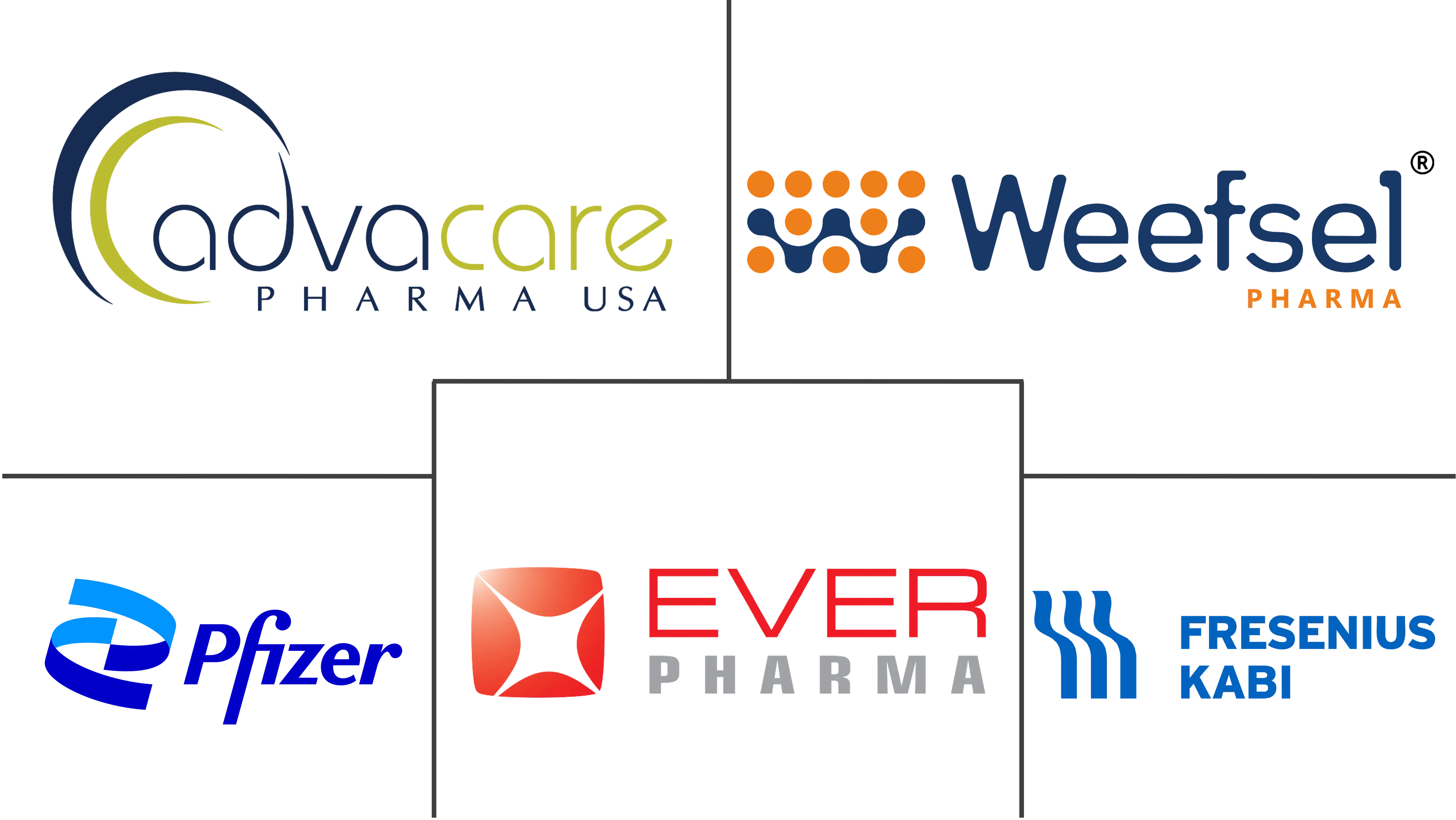Oxytocin Market Size and Share
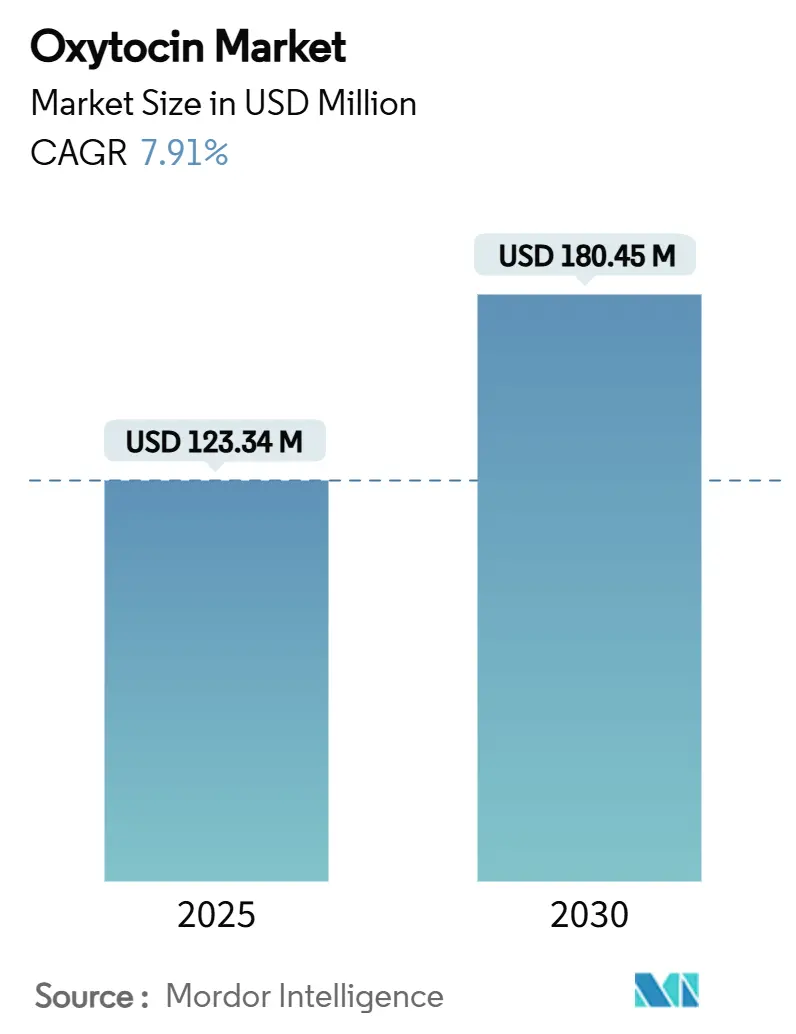
Oxytocin Market Analysis by Mordor Intelligence
The oxytocin market size stands at USD 123.34 million in 2025 and is forecast to reach USD 180.45 million in 2030, reflecting a 7.91% CAGR. Rising postpartum hemorrhage (PPH) cases, expanding institutional deliveries in emerging economies, and technological advances in thermostable and needle-free formulations underpin this steady expansion. Global demographic trends amplify demand: live-births remain elevated in Asia-Pacific while advanced maternal age in OECD markets raises obstetric complexity. Regulatory moves—especially the 2024 WHO/FIGO protocol update mandating active third-stage management—further increase utilization rates. At the same time, supply chain fragility, exemplified by the 2024 United States injectable drug shortage, forces health systems to diversify sourcing and adopt conservation protocols. Innovation centered on intranasal and oromucosal delivery widens application horizons beyond routine obstetrics, positioning the oxytocin market for durable growth despite cold-chain cost pressure.
Key Report Takeaways
- By indication, postpartum applications commanded 63.23% of the oxytocin market share in 2024, while the antepartum segment is projected to grow at an 8.45% CAGR through 2030.
- By route of administration, parenteral products held 78.91% revenue share in 2024; oromucosal formats are poised for the fastest 8.56% CAGR to 2030.
- By distribution channel, hospital pharmacies captured 68.98% share of the oxytocin market size in 2024; retail pharmacies are expanding at an 8.61% CAGR.
- By geography, North America led with 43.12% revenue share in 2024; Asia-Pacific is set to record the highest 8.88% CAGR through 2030.
Global Oxytocin Market Trends and Insights
Drivers Impact Analysis
| Driver | ( ~ ) % Impact on CAGR Forecast | Geographic Relevance | Impact Timeline |
|---|---|---|---|
| Rising obstetric complications | +1.2% | Global (higher in LMIC) | Medium term (2-4 years) |
| Increasing live-births in emerging economies | +1.8% | Asia-Pacific, Sub-Saharan Africa | Long term (≥ 4 years) |
| Updated WHO/FIGO labour-management guidelines | +0.9% | Global | Short term (≤ 2 years) |
| Wider intranasal OT pipeline | +1.1% | North America, Europe | Medium term (2-4 years) |
| Low cost of production | +0.7% | Global | Short term (≤ 2 years) |
| Thermostable OT formulations | +1.4% | Asia-Pacific, Africa, Latin America | Long term (≥ 4 years) |
| Source: Mordor Intelligence | |||
Rising Obstetric Complications
Advanced maternal age now accounts for more than 20% of births in developed markets, creating 2.5-fold higher risks of dystocia and uterine atony [1]American College of Obstetricians and Gynecologists, “Clinical Guidance for Labor Induction,” acog.org . Cesarean delivery prevalence reached 32% worldwide in 2024, and parturients with prior cesareans require infusion rates of 27.7 IU/h versus 14.6 IU/h for standard cases. Asia-Pacific mirrors this demographic pattern but faces workforce shortages, leaving hospitals reliant on high-potency oxytocin formulations. These factors elevate the drug from a routine uterotonic to a critical, dose-sensitive intervention in complex deliveries.
Increasing Live-Births in Emerging Economies
Institutional birth rates in India jumped from 39% to 79% between 2005 and 2015 as incentive programs and cultural shifts encouraged hospital deliveries. Up to 23% of these births now need oxytocin compared with historical levels below 15%. Similar demographic dividends in Indonesia, Nigeria, and Pakistan reinforce sustained volume growth. Manufacturers are responding by investing in localized fill-finish plants and last-mile logistics networks to meet the structural shift in demand.
Updated WHO/FIGO Labour-Management Guidelines
The 2024 WHO/FIGO update standardized active third-stage care protocols, anchoring oxytocin as the primary prophylactic agent. North American and European facilities already report 80% compliance, but uptake lags at 45% in many low- and middle-income countries (LMIC) [2]Alyssa R. Hersh, "Third stage of labor: evidence-based practice for prevention of adverse maternal and neonatal outcomes," American Journal of Obstetrics and Gynecology, sciencedirect.com. Implementation drives procurement of pre-filled syringes and auto-injectors that simplify nurse training, spurring incremental unit growth even where birth volumes are static.
Wider Intranasal OT Pipeline
Tonix Pharmaceuticals secured FDA orphan drug designation for TNX-2900 in June 2024, validating intranasal delivery for Prader-Willi syndrome. Clinical trials show 12% bioavailability—adequate for both central-nervous-system and uterotonic effects—while eliminating needles and cold-chain dependence. Similar candidates targeting pain, autism spectrum disorders, and metabolic dysfunction diversify revenue beyond cyclical obstetric demand.
Restraints Impact Analysis
| Restraint | ( ~ ) % Impact on CAGR Forecast | Geographic Relevance | Impact Timeline |
|---|---|---|---|
| Stringent Rx controls & GMP cold-chain costs | -0.8% | Global, acute in tropics | Short term (≤ 2 years) |
| Adverse-event scrutiny | -0.6% | North America, Europe | Medium term (2-4 years) |
| Homebirth/minimal-intervention trends | -0.4% | North America, Europe, Australia | Long term (≥ 4 years) |
| Recurring API shortages | -1.1% | Global, severe in North America | Short term (≤ 2 years) |
| Source: Mordor Intelligence | |||
Stringent Rx Controls & GMP Cold-Chain Costs
Mandatory refrigeration during transit raises logistics expenses by 15-25% in high-temperature regions. Studies reveal shipment excursions from -9.9 °C to +30.1 °C, compromising potency and triggering batch recalls. Regulatory inconsistencies—some labels permit ≤25 °C storage without demonstrable stability gain—force multinationals to navigate divergent rules, escalating compliance costs [3]World Health Organization (WHO), "Appropriate Storage and Management of Oxytocin – a Key Commodity for Maternal Health", who.int.
Recurring API Shortages from Supply-Chain Consolidation
Only a handful of peptide manufacturers dominate global output; Fresenius Kabi’s 2024 production halt precipitated a nationwide shortage in the United States. Hospitals rationed oxytocin, adopted reduced-dose regimens, and reported scheduling delays for elective inductions. China’s shortage registry lists 980 drugs, 92.65% of them injectables, underscoring systemic fragility when sterile injectables cluster in a few plants.
Segment Analysis
By Indication: Postpartum Dominance Drives Market Stability
The postpartum indication represented 63.23% of oxytocin market share in 2024, anchored by WHO first-line guidelines for PPH prevention. Consequently, it forms the revenue base that steadies topline growth across developed and emerging regions. The antepartum segment, although smaller, is forecast to expand at an 8.45% CAGR through 2030, propelled by older maternal age and updated ACOG protocols recommending both low- and high-dose augmentations to curb operative deliveries. Rising infusion rates in elderly parturients reinforce volume gains. Manufacturers therefore align R&D pipelines with divergent needs: fast-acting injectables for postpartum emergencies and controlled-release systems that moderate uterine response during inductions.
Meanwhile, academic centers are testing algorithm-based dosing that tailors antepartum oxytocin infusions to patient BMI and parity. Such precision approaches could moderate total unit volumes but upgrade demand for smart-pump compatible formulations. This balancing act signals sustained mid-single-digit growth for postpartum products and upper-single-digit gains for antepartum therapies throughout the forecast horizon.
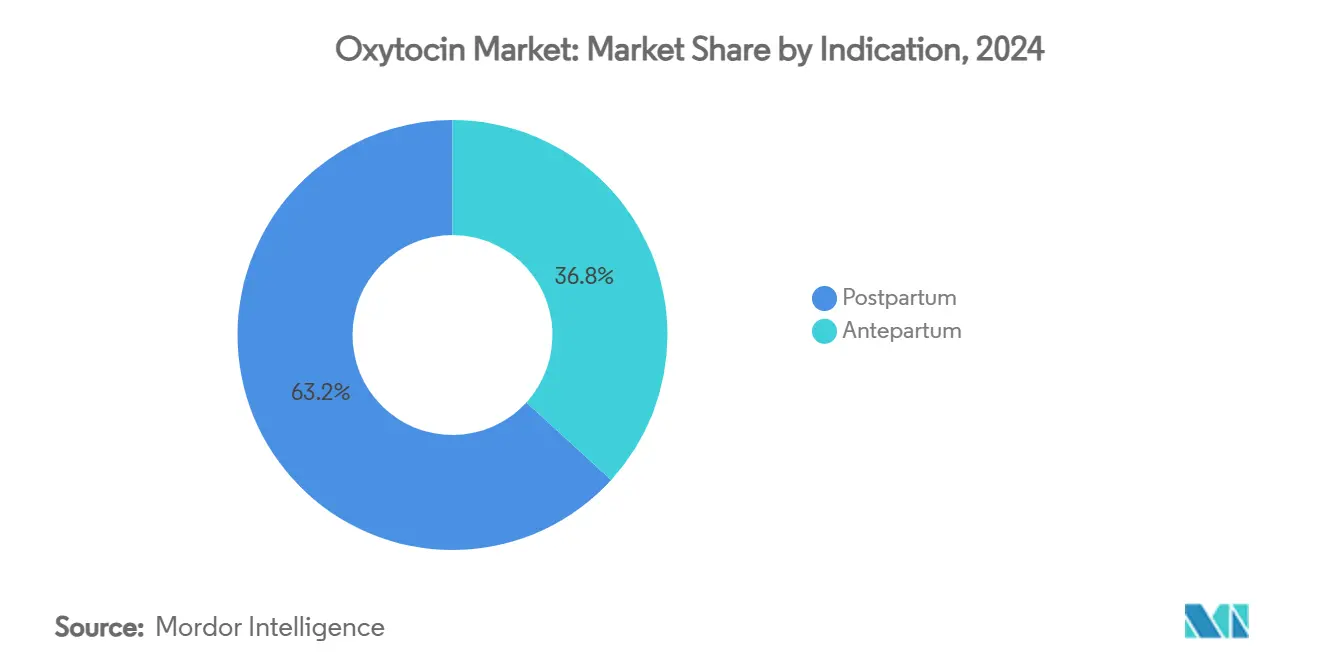
By Route of Administration: Parenteral Leadership Faces Innovation Pressure
Injectables dominated with 78.91% of 2024 revenue, reflecting clinician familiarity and low unit cost. Nonetheless, oromucosal formats are tracking an 8.56% CAGR, led by medicated lollipops and thin-film strips suitable for community midwives. Intranasal sprays, though presently niche, ride on FDA orphan-designation momentum and could cannibalize a fraction of inpatient volumes once head-to-head trials confirm equivalence.
Parenteral suppliers defend their base through ready-to-use syringes that cut preparation time by 30% and reduce dosing errors. Oromucosal innovators, by contrast, tout ambient-temperature stability and user comfort. In LMIC settings without reliable power grids, heat-stable oromucosal or intranasal formats could displace injectables entirely, posing a medium-term risk to entrenched parenteral players.
By Distribution Channel: Hospital Dominance Challenged by Retail Expansion
Hospital pharmacies controlled 68.98% of the oxytocin market size in 2024, driven by inpatient delivery volumes and immediate access requirements during obstetric emergencies. Retail outlets, however, are scaling at an 8.61% CAGR as outpatient induction protocols and home-use intranasal products progress through late-stage trials. Tele-consult–driven prescription fulfillment further accelerates over-the-counter pick-up for follow-on doses after discharge.
Cold-chain complexity still tilts the field toward hospitals, but thermostable sublingual tablets under Phase II evaluation may unlock wider retail reach. Supply-chain planners now segment stock-keeping units: chilled injectable packs for institutional buyers and shelf-stable oral sprays for pharmacies. This dual-track model increases manufacturer margin diversification but demands granular demand forecasting to avoid expiries.
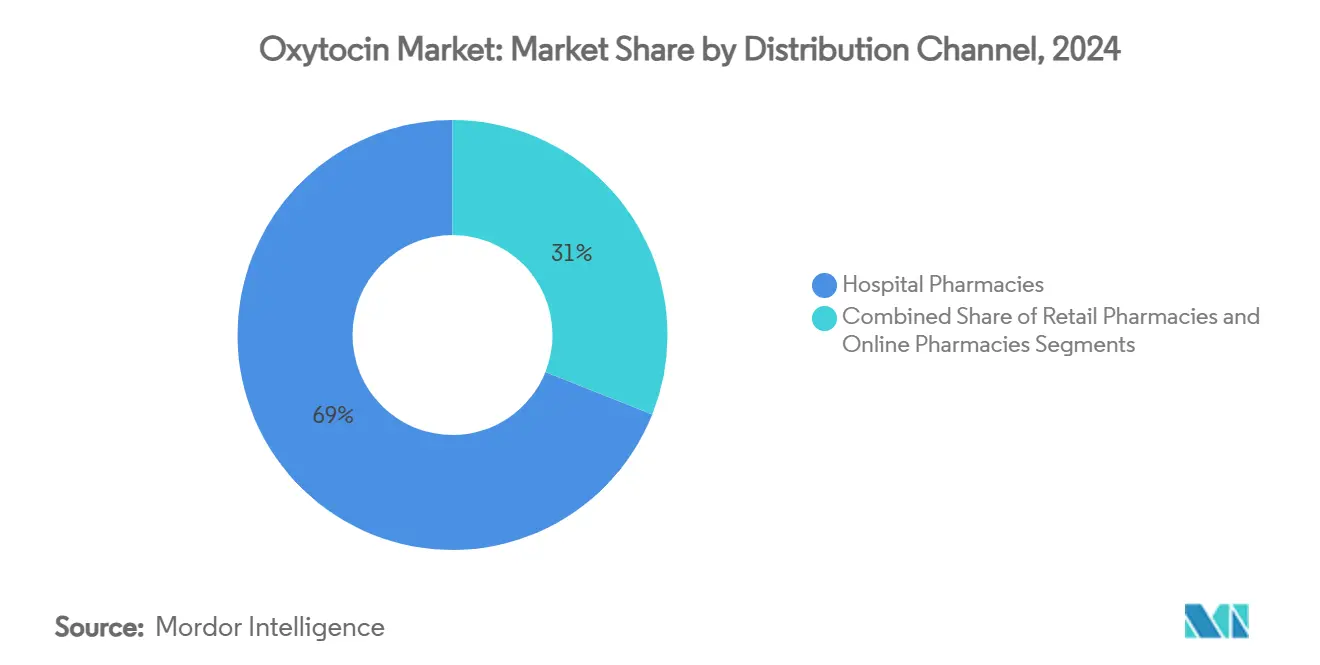
Note: Segment shares of all individual segments available upon report purchase
Geography Analysis
North America generated 43.12% of 2024 revenue, supported by high PPH intervention rates and generous insurer reimbursement. Yet supply disruptions exposed dependence on offshore active pharmaceutical ingredient (API) plants, prompting policy debates on reshoring critical drug manufacturing. Asia-Pacific, meanwhile, is projected to deliver an 8.88% CAGR to 2030 as India, China, and Indonesia upgrade maternity wards and scale midwife training. Government tender volumes already surpass those of many OECD peers.
Asia-Pacific’s ascendance reshapes global supply-demand balance. India’s Janani Suraksha Yojana program finances facility births and free uterotonics, driving 10-year oxytocin unit growth that outpaces population expansion. China’s 2025 pharmaceutical modernization plan accelerates domestic peptide approvals, encouraging local fill-finish investments. Together, these markets will likely eclipse North American volume by 2027. Infrastructure disparities persist, but bilateral aid initiatives fund cold-chain upgrades in rural clinics, narrowing the access gap.
Europe maintains low-single-digit growth as universal insurance ensures steady procurement, while Latin America and Africa exhibit upside tempered by infrastructure gaps. For multinational suppliers, success hinges on portfolio localization—heat-stable strips for equatorial Africa, auto-injectors for European ambulances, and cost-efficient multidose vials for US hospital groups.
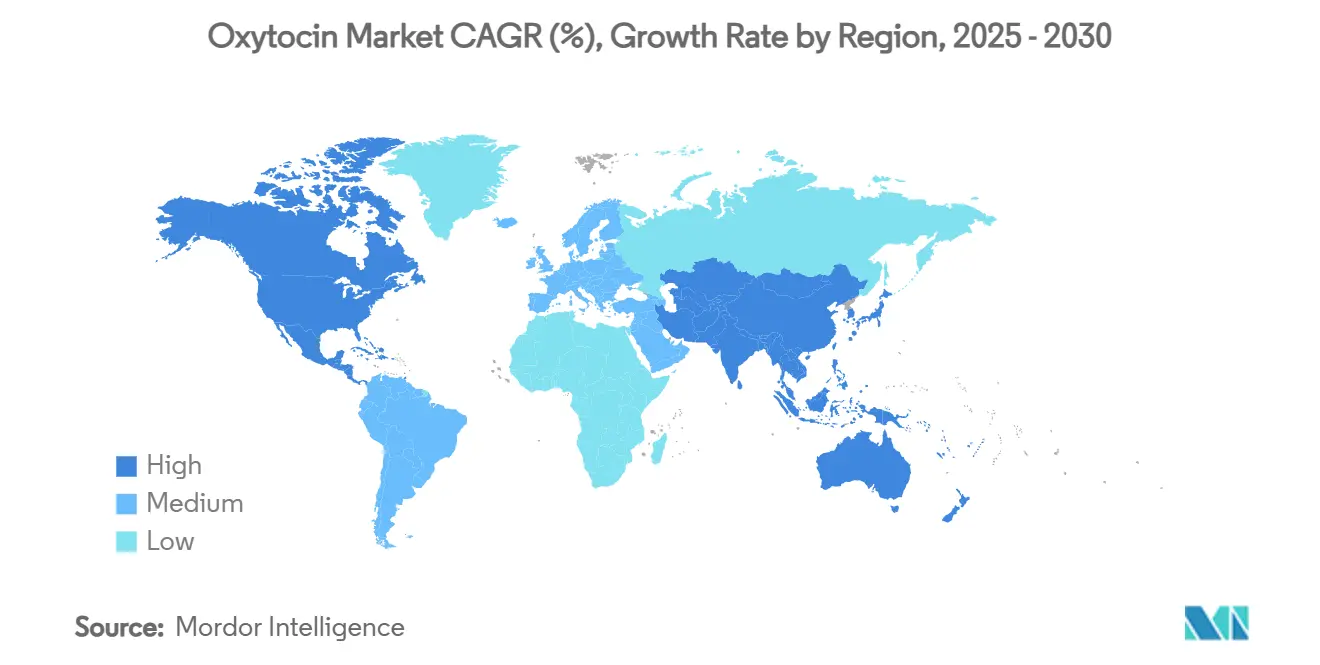
Competitive Landscape
The oxytocin industry comprises a mix of global incumbents and region-specific specialists. Pfizer’s monopoly on branded Pitocin in the United States grants hospital formulary loyalty, while Fresenius Kabi and Hikma dominate generic injectables across Europe and the Middle East. Mid-tier players such as CordenPharma scale peptide APIs for third parties, underpinning contractual manufacturing growth. Market entrants—including Tonix Pharmaceuticals and Insud Pharma—concentrate on delivery innovation: intranasal sprays and thermostable sublingual tablets target unmet needs in both high-income outpatient care and LMIC outreach.
Strategic responses to recent shortages include dual-sourcing APIs, vertical integration, and regional redundancy. CordenPharma’s EUR 900 million peptide platform expansion adds European capacity that mitigates dependence on Asian intermediates. Partnerships like Kinoxis Therapeutics-Boehringer Ingelheim explore neuropsychiatric indications, mitigating obstetric cyclicality.
Patent activity intensifies around formulation stability, with microneedle patches and heat-sensitive color indicators leading the pipeline. The competitive environment thus rewards scale, quality compliance, and delivery science, leaving formulary share fluid for innovators able to pair regulatory agility with credible supply assurances.
Oxytocin Industry Leaders
-
Pfizer Inc.
-
Weefsel Pharma
-
EVER Pharma
-
AdvaCare Pharma
-
Fresenius Kabi AG
- *Disclaimer: Major Players sorted in no particular order

Recent Industry Developments
- November 2024: University of Queensland scientists unveiled gut-stable oral oxytocin analogs for chronic abdominal pain, broadening non-obstetric commercial horizons. University of Queensland
- November 2024: Insud Pharma secured USD 2.7 million Gates Foundation funding to advance Phase II trials of a sublingual oxytocin for PPH prevention.
- June 2024: Kinoxis Therapeutics and Boehringer Ingelheim inked a USD 181 million co-development pact for oxytocin-based precision psychiatry treatments.
- June 2024: CNRS and University of Strasbourg patented non-peptidergic oxytocin receptor agonists aimed at aging, alcoholism, and pain therapies.
Global Oxytocin Market Report Scope
As per the scope of the report, oxytocin is a hormone made in the brain that plays a role in childbirth and lactation by causing muscles to contract in the uterus (womb) and the mammary glands in the breast. The Oxytocin Market is segmented by Indication (Antepartum, Postpartum), Distribution Channel (Hospital Pharmacies, Drug Stores, Online Pharmacies) Geography (North America, Europe, Asia-Pacific, Middle East and Africa, and South America). The market report also covers the estimated market sizes and trends for 17 countries across major regions globally. The report offers the value (in USD million) for the above segments.
| Antepartum |
| Postpartum |
| Parenteral |
| Intranasal |
| Oromucosal |
| Hospital Pharmacies |
| Retail Pharmacies |
| Online Pharmacies |
| North America | United States |
| Canada | |
| Mexico | |
| Europe | Germany |
| United Kingdom | |
| France | |
| Italy | |
| Spain | |
| Rest of Europe | |
| Asia-Pacific | China |
| Japan | |
| India | |
| Australia | |
| South Korea | |
| Rest of Asia-Pacific | |
| Middle East and Africa | GCC |
| South Africa | |
| Rest of Middle East and Africa | |
| South America | Brazil |
| Argentina | |
| Rest of South America |
| By Indication | Antepartum | |
| Postpartum | ||
| By Route of Administration | Parenteral | |
| Intranasal | ||
| Oromucosal | ||
| By Distribution Channel | Hospital Pharmacies | |
| Retail Pharmacies | ||
| Online Pharmacies | ||
| By Geography | North America | United States |
| Canada | ||
| Mexico | ||
| Europe | Germany | |
| United Kingdom | ||
| France | ||
| Italy | ||
| Spain | ||
| Rest of Europe | ||
| Asia-Pacific | China | |
| Japan | ||
| India | ||
| Australia | ||
| South Korea | ||
| Rest of Asia-Pacific | ||
| Middle East and Africa | GCC | |
| South Africa | ||
| Rest of Middle East and Africa | ||
| South America | Brazil | |
| Argentina | ||
| Rest of South America | ||
Key Questions Answered in the Report
What is the current oxytocin market size and projected growth?
What is the current oxytocin market size and projected growth?
Which indication generates the highest revenue?
Postpartum hemorrhage prevention and treatment dominate, contributing 63.23% of 2024 revenue.
Which region will grow the fastest through 2030?
Asia-Pacific is poised for the highest CAGR at 8.88%, driven by expanding institutional deliveries and demographic momentum.
What delivery innovations are reshaping the market?
Intranasal sprays, oromucosal strips, and thermostable sublingual tablets are gaining traction, offering needle-free administration and reduced cold-chain reliance.
How are supply shortages being addressed?
Manufacturers are investing in redundant API sources, domestic fill-finish capacity, and strategic stockpiles to mitigate recurring injectable shortages.
Who are the leading players in the oxytocin industry?
Pfizer, Fresenius Kabi, and Hikma lead injectable supply, while Tonix Pharmaceuticals and Insud Pharma drive alternative delivery innovations.
Page last updated on:
